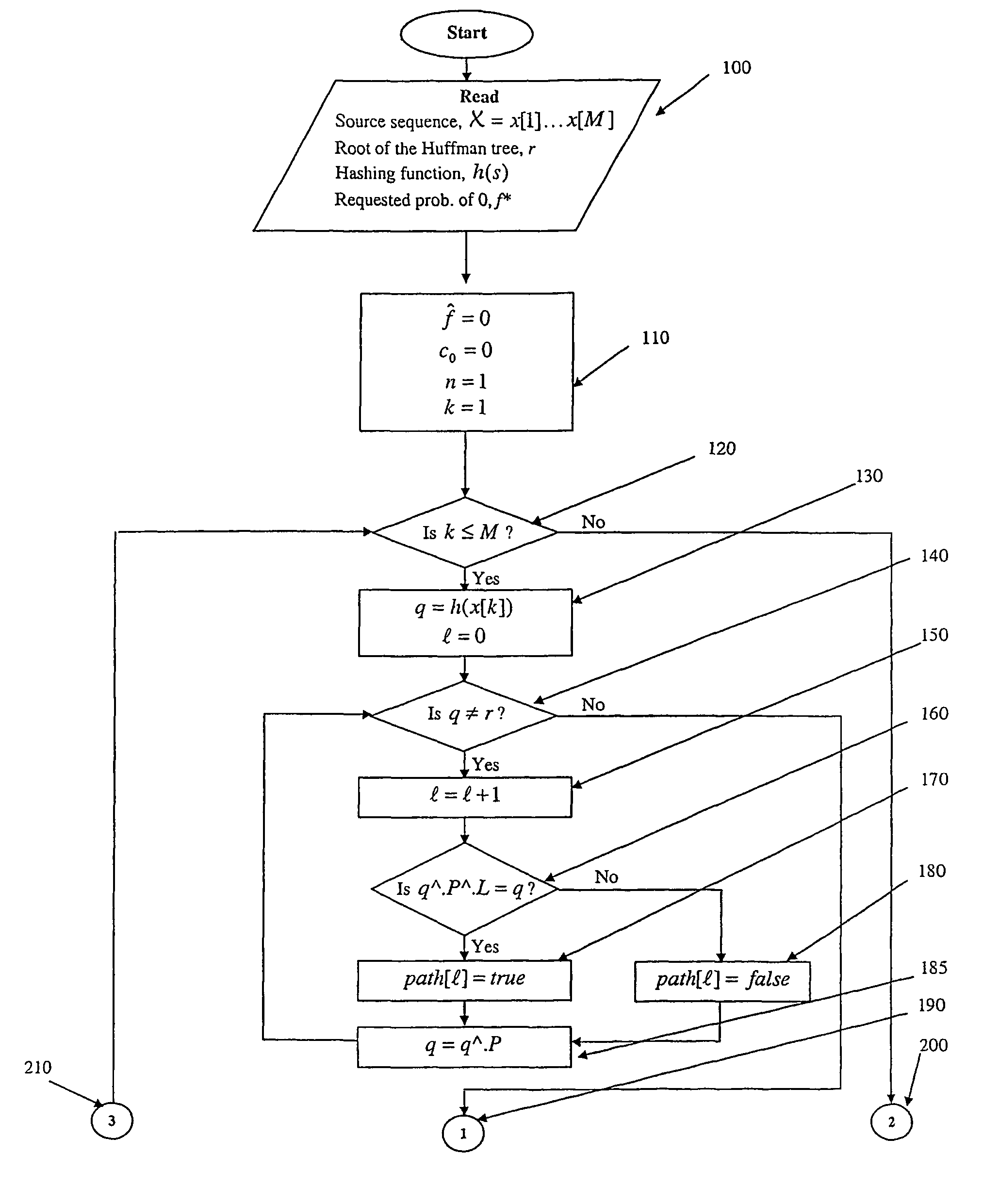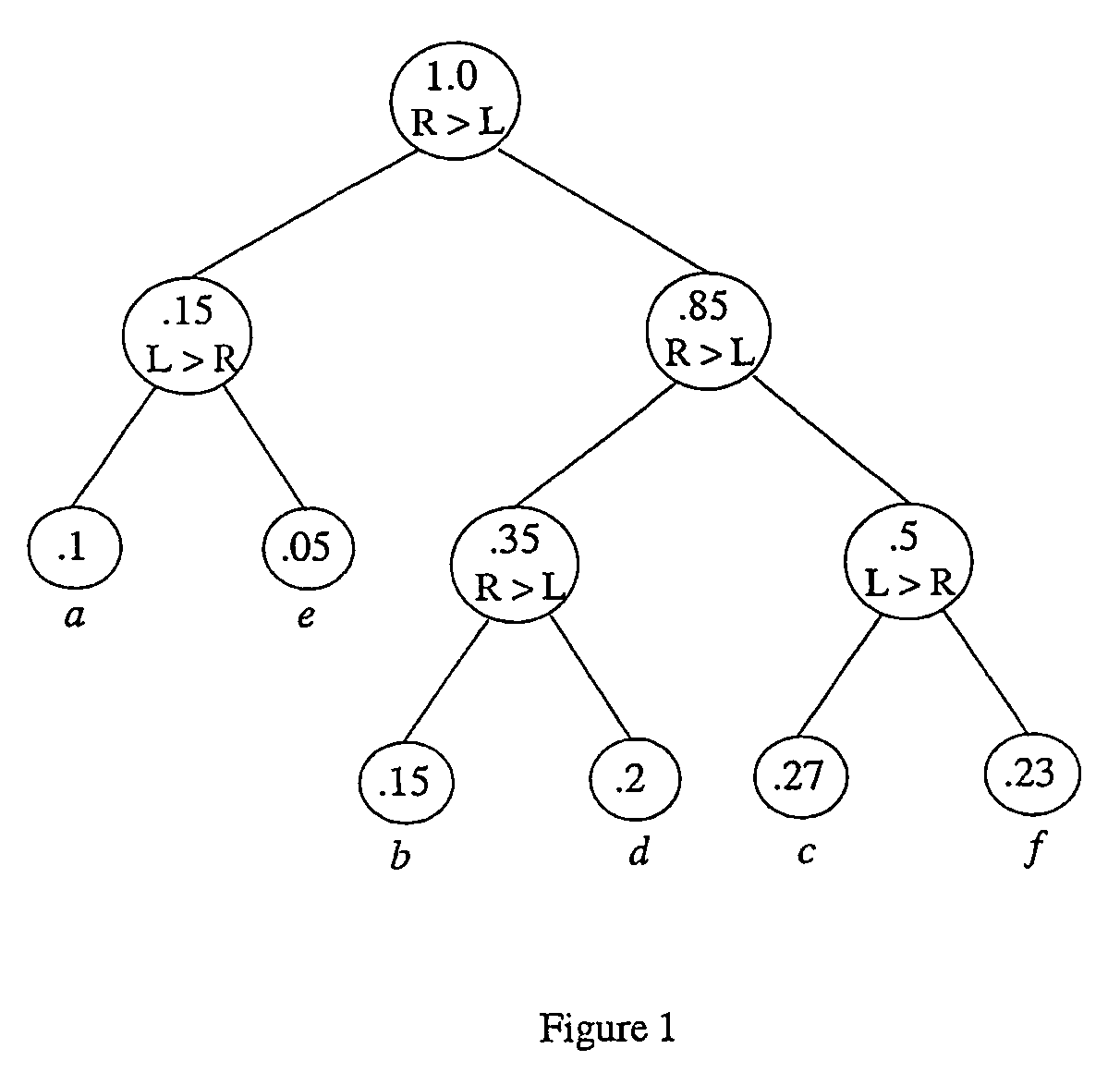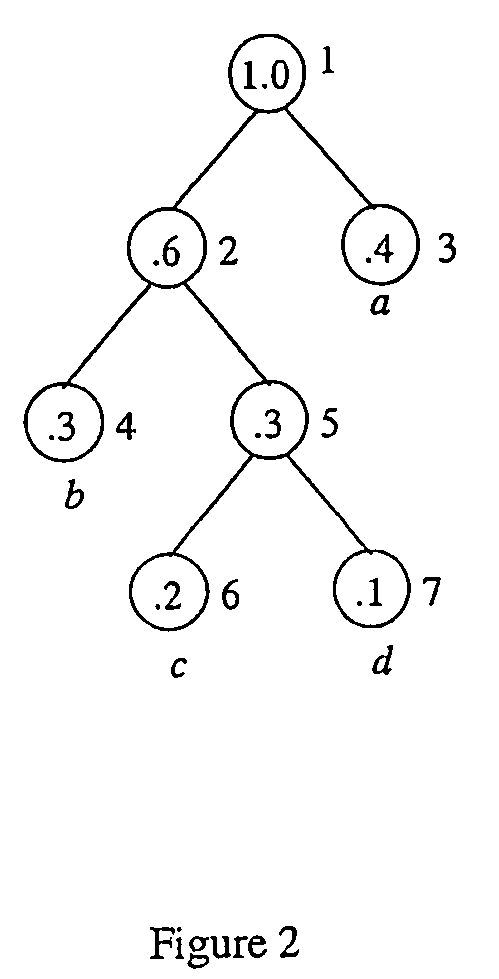Cryptosystem for data security
a cryptosystem and data technology, applied in the field of data encoding and encryption, can solve the problems of inability to control the probabilities of output symbols, inability to achieve perfect secrecy in real-life cryptosystems, user loss of control of contents and statistical properties of compressed/encoded files, etc., to achieve optimal and lossless compression of input data streams
- Summary
- Abstract
- Description
- Claims
- Application Information
AI Technical Summary
Benefits of technology
Problems solved by technology
Method used
Image
Examples
example 1
[0117]Consider S={a, b, c, d}, P={0.4, 0.3, 0.2, 0.1}, A={0, 1}, and the encoding schemes φA: S→CA={1, 00, 010, 011} and φB: S→CB={0, 10, 110, 111}, generated by using different labeling strategies on the Huffman tree depicted in FIG. 1. The superior encoding scheme between φA and φB, such that F*={0.5, 0.5}, is sought for.
[0118]First, the average code word length of bits per symbol is calculated (see Hankerson et al. (Introduction to Information Theory and Data Compression, CRC Press, (1998))) for the exact formula for computing it) for both encoding schemes: lA= lB=1(0.4)+2(0.3)+3(0.2)+3(0.1)=1.9.
[0119]Second, the distance for φA and φB from the optimal distribution, dA(FA, F*) and dB(FB, F*) respectively, are calculated, by using (15) where Θ=2, as follows:
[0120]f0A=0(0.4)+2(0.3)+2(0.2)+1(0.1)1.9≈0.57895,f1A=1(0.4)+0(0.3)+1(0.2)+2(0.1)1.9≈0.42105,
dA(FA,{circumflex over (F)})=|0.57895−0.5|2+|0.42105−0.5|2=0.012466,
[0121]f0B=1(0.4)+1(0.3)+1(0.2)+0(0.1)1.9≃0.47368,f1B=...
example 2
[0124]Consider S={a, b, c, d} and A={0, 1}. Suppose that the requested probability of 0 in the output is f*=0.5. There are 2m−1=8 possible encoding schemes whose code word lengths are {1, 2, 3, 3} (those generated from the Huffman tree depicted in FIG. 1 obtained by using different labeling strategies).
[0125]The eight possible encoding schemes, their probabilities of 0 in the output, and their distances, as defined in (14) where Θ=2, are given in Table 1.
[0126]
TABLE 1All possible encoding schemes for the code word lengths {1,2, 3, 3}, where S = {a, b, c, d}, A = {0,1}, and P = {0.4, 0.3, 0.2, 0.1}.jφj: S → Cjfd(F, F*)1{0, 10, 110, 111}0.473680.0013852{0, 10, 111, 110}0.421050.0124663{0, 11, 100, 101}0.473680.0013854{0, 11, 101, 100}0.421050.0124665{1, 00, 010, 011}0.578950.0124666{1, 00, 011, 010}0.526320.0013857{1, 01, 000, 001}0.578950.0124668{1, 01, 001, 000}0.526320.001385
[0127]Observe that none of these encodings yield the optimal value of f*=0.5. Indeed, the smallest distance ...
example 3
[0133]Consider the source alphabet S={a, b, c, d} with respective probabilities of occurrence P={0.4, 0.3, 0.2, 0.1} and the code alphabet A={0, 1}. To encode the source sequence X=bacba, D_S_H_Em,2, the Huffman tree (shown in FIG. 1) is first constructed using Huffman's algorithm (see Huffman (A Method for the Construction of Minimum Redundancy Codes, f Proceedings of IRE, 40(9):1098-1101, (1952))).
[0134]The encoding achieved by Process D_S_H_Em,2 is detailed in Table 2. First, c0(0), n, and {circumflex over (f)}(0) are all set to 0. The starting branch assignment
[0135]
TABLE 2Encoding of the source sequence X = bacba usingD_S_H_Em, 2 and the Huffman tree of FIG. 1.The resulting output sequence is y = 011010011.nx[k]Pathc0(n){circumflex over (f)}(n)Assign.Goy[n + 1]0bLL00.00000-1L0111.00001-0L12aR10.50000-1R13cLRL10.33330-1L0420.50000-1R1520.40000-1L06bLL30.50000-1L0740.57141-0L18aR40.50000-1R1940.4444
is 0-1. For each symbol of X, a path is generated, and for each element of this pa...
PUM
 Login to View More
Login to View More Abstract
Description
Claims
Application Information
 Login to View More
Login to View More - R&D
- Intellectual Property
- Life Sciences
- Materials
- Tech Scout
- Unparalleled Data Quality
- Higher Quality Content
- 60% Fewer Hallucinations
Browse by: Latest US Patents, China's latest patents, Technical Efficacy Thesaurus, Application Domain, Technology Topic, Popular Technical Reports.
© 2025 PatSnap. All rights reserved.Legal|Privacy policy|Modern Slavery Act Transparency Statement|Sitemap|About US| Contact US: help@patsnap.com



